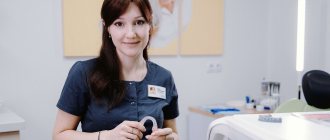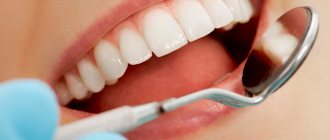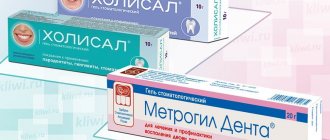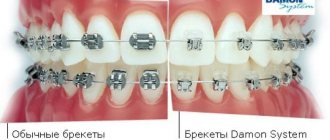An orthodontist is the most difficult one to choose. This is not a doctor who can treat 1-2 teeth and, if you don’t like it, refuse. On average, it takes 2 years to correct a bite, and the success of therapy can be judged 3-5 years after its completion. Therefore, you have to rely only on information about the doctor, reviews and personal impressions during the consultation.
The rating of Moscow orthodontists will help you decide. The review examines the best specialists in this profile, describes their specializations and strengths, and provides real patient responses.
Who is an orthodontist and what does he do?
Orthodontists deal with anomalies in the development of the dental system. These are doctors who correct crooked teeth and normalize jaw closure (occlusion or bite).
The etymology of the term will help you understand who an orthodontist is. From Greek “orthos” means “straight” and “odontos” means “tooth”. That is, the concept is literally translated as “straight tooth.”
When treating, orthodontists pursue the following goals:
- obtaining a physiologically natural bite, normalization of contacts, proper overlap of the incisors;
- achieving correct teeth alignment and parallelism of roots;
- preparation for rational splinting, prosthetics or implantation;
- creating conditions for normal periodontal trophism (tissues adjacent to the teeth).
To achieve these goals, specialists use hardware and surgical techniques. In severe cases (with serious anomalies of the facial skeleton), they involve gnathological surgeons to help.
Orthodontists deal with anomalies in the development of the dental system
Various diseases and oral health
An orthodontist is in charge of various anomalies in the development of the dentofacial apparatus and occlusion. This:
- all kinds of malocclusions – distal, mesial, cross, open, deep;
- improper formation and growth of crowns - crowding, dystopia (non-physiological position, curvature), retention (unerupted units), diastema and trema (large interdental gaps);
- defects of dental arches;
- Difficulties with chewing, diction and breathing due to occlusion abnormalities.
Orthodontists also deal with various defects in the formation of facial bones and disorders of the temporomandibular joint (TMJ). In general, malocclusion affects not only the condition of the dental system, but almost all systems, including the respiratory, digestive and spine. Therefore, specialists in this profile view the body comprehensively and are savvy in many areas of medicine.
Aesthetic dentistry
Orthodontics is sometimes defined as a subsection of aesthetic dentistry. This is due to the fact that the process of bite alignment improves not only functional processes, but also external ones: the patient’s facial features and smile become more beautiful.
Improving appearance is an important psycho-emotional factor. After orthodontic treatment, patients feel more confident, more attractive, and are more willing to meet and communicate with people.
What techniques does the orthodontist use?
To normalize occlusion, orthodontists resort to various techniques:
- Myotherapy. This is gymnastics for the facial muscles. Its regular implementation contributes to the correct formation and correction of facial features and skeleton. Typically, the method is used in young children who cannot yet have devices installed. It is also prescribed to adults - as an auxiliary method and to consolidate the result after the main treatment.
- Hardware techniques. They involve the use of three types of structures: myofunctional devices (activators, trainers, etc.), fixed (braces) and removable (aligners, plates) orthodontic devices.
- Surgical. There are two types: standard and special. The first include tooth extractions, incisions in the gums, etc. They are performed by ordinary surgeons on almost all patients. And the second type of intervention belongs to the section of orthodontics and gnathology. These can be complex operations on the facial skeleton, to expand the dental arch or move the jaws to the desired position, etc. These manipulations are performed by a maxillofacial surgeon or a gnathologist surgeon.
Also, when leveling the bite, they resort to other types of interventions: installation of microimplants, partial dentures, etc. Treatment by a dentist cannot be avoided: before and during bite alignment, professional hygiene and timely elimination of dental diseases are mandatory.
The choice of technique depends on the severity of the pathology, the condition of the dental system and the age of the patient. Usually several methods are used at once. Since bite defects affect many systems of the body, an integrated approach is the only correct option for correcting the anomaly.
To correct the bite, several methods are often used in combination.
When should you contact an orthodontist?
Typically, teenagers or adults come to the orthodontist with specific complaints about malocclusions. But it is advisable for everyone to visit this specialist from early childhood: it is not always possible to independently detect a problem at the beginning of its development. Such preventive visits will help identify the defect “in the bud” - when it is as easy as possible and, importantly, cheap to fix.
Therefore, a child is first shown to an orthodontist at 2-3 years of age, when most of the baby teeth have erupted. If everything is in order, then the second preventive visit is carried out at 5-6 years - during this period, temporary units begin to be replaced by radical ones.
Children must be shown to an orthodontist if:
- labored breathing;
- difficulty swallowing and chewing food;
- diction disorders;
- bad oral habits: mouth breathing, sucking fingers, pacifiers, pens, etc.;
- severe bite pathologies;
- crowding and unevenness of the teeth - even if the “milk jugs” are crooked, the child is taken to the doctor: the location of the temporary units affects how even the permanent crowns grow;
- large interdental spaces and crevices.
All these points apply to adults as well. If you are worried about the curvature of your teeth, find it difficult to eat and breathe, or are embarrassed to smile, make an appointment with an orthodontist.
A child is first shown to an orthodontist at 2-3 years of age.
How to choose a good orthodontist?
Of course, such an article on the website of a particular clinic looks a little strange. But this is not just advertising. Our task is to inform potential patients and increase their literacy level. After all, this is beneficial for all doctors who try to do their work conscientiously.
So how do you choose a good orthodontist?
Perhaps this is one of the main questions for a person who wants to find a beautiful smile and get the correct bite. Therefore, it must be taken seriously. After all, it is the orthodontist who will treat you, and not the braces or arches themselves.
Unfortunately, a traditional myth is firmly rooted in the minds of a significant part of people: anyone can work poorly, but ALL DOCTORS ARE GOOD (how could it be otherwise, “they studied” - a quote from real life). Nobody is perfect. Like representatives of the vast majority of other specialties (except, perhaps, special forces and astronauts), doctors can be both good and bad. And the more complex the area, the more second ones there are.
Check out a few facts:
Doctors are good and bad, and so are the results of treatment.
The main difficulty is that the process of eliminating dental anomalies is quite long (one and a half to two years, and sometimes more). It’s very unpleasant to realize after such a long period of time that nothing good came of it. Of course, no one dies from bad treatment, but time, money and hopes are wasted, the condition of the teeth and bite has not improved, sometimes worsened, there is no more trust in doctors...
The vast majority of competent specialists really do not like working with patients from other orthodontists, since this is the most thankless task (those of my colleagues who do this conscientiously evoke my genuine respect). In general, the circle closes, and it is extremely difficult to correct the situation.
Of course, the surest way to check a doctor’s qualifications is to undergo treatment with him :). But precisely because this process is quite long, you will only be able to understand something about the quality of the result closer to its end. But in fact - only 3-5 years after (!) treatment. Basically, it's too late.
Therefore, it is extremely difficult for a patient to objectively assess the qualifications of an orthodontist. Of course, you can see whether there is logic and clarity in the doctor’s words or not, and at least get your bearings based on this.
More often than not, people rely on indirect signs, the main of which they consider the level of the clinic (promotion, brand, service, cost of treatment). To some extent, this is due to the quality of work on correcting dental anomalies, but in our country, unfortunately, this is not always the case. Although the situation is changing for the better, it is precisely due to the legibility of an increasingly large part of patients and significantly increased competition. Nowadays, clinics that value their reputation will not hire just anyone to work for them.
But what are the evaluation criteria here? This is not the USA, where if a person’s resume says that he graduated from, for example, Princeton, then it is unlikely that he is a bad specialist. In our country, to be honest, a diploma from any educational institution does not guarantee anything. Well, firstly, everyone knows how some students pass exams, and secondly, simply because modern orthodontics is practically not taught at the institute. It is studied mainly after university, during postgraduate training, which again varies.
When a dental therapist is hired, he may be asked to treat his friends or relatives to demonstrate his qualifications, and this is correct. You and I understand perfectly well that this cannot be done with an orthodontist. So, the difficulty lies in the fact that the clinic administration, just like you, dear patient, cannot objectively determine the qualifications of a specialist, since only a few are able to show the results of their work.
Therefore, when choosing an orthodontist, many chief doctors of clinics focus only on subjective factors (experience, ability to present themselves, acquaintance, etc.). An interesting topic is raised here, that objective methods for assessing a doctor’s qualifications do not exist at all. There is a system of categories that are awarded only (!) based on length of service. At the Congress of Russian Orthodontists in 2012, one of our respected professors absolutely rightly joked that, in principle, if you follow the modern logic of the state system for assessing categories, then you can simply say age and the higher it is, the higher the qualification)). But still, specialists working in one of the most rapidly developing areas of medicine, this is not cognac, where the aging time does not always reflect the quality.
In general, high-level clinics are trying to introduce a quality control system and standards of care, and this is the hope. But it is still better to evaluate the doctor, because there are only a few such medical centers where truly good standards exist and are actually followed.
A prestigious clinic does not guarantee the high qualifications of an orthodontist due to the specifics of the profession.
How do you choose?
I’ll say right away that there is no 100% method.
The whole matter is further complicated by the fact that a good result is only one that will be stable for many years. Anyone can simply straighten their teeth. Therefore, most patients in the short term are satisfied with the treatment and the doctor, but it’s a different matter after 3-5 years. There is still such a danger here. There are situations when a person is satisfied with his doctor and treatment, although objectively the result is bad. This happens quite often. Why? Because no matter how trivial it may be, there are two extreme categories of doctors (I will specifically describe the pure types, although in real life you rarely see such people):
- A sullen doctor, a perfectionist who is always dissatisfied with his work, as he strives for perfection.
- An “easy” orthodontist, directing his energy rather not to fighting for an ideal, but to explaining to the patient what is already good, or rather simply wonderful.
From a doctor from the first group you will not hear such epithets as “wonderful”, “excellent”. It is difficult for him to “sell” treatment and he does not know how to present the results of his work. The doctor from the second group is a talented communicator and can put on a “good face on a bad game” without any problems (because he is sincere). Patients of orthodontists from the second group are always in the short (!) term more satisfied with the results of treatment, despite their unsatisfactory quality.
Obviously, Marya Sidorovna (a fictional character, any coincidence with real people is an accident), who went to a one-day seminar and learned how to somehow glue braces to her teeth, will be absolutely sincerely happy that her smile will become better than it was. The bite and all sorts of “little things” that 1000% distinguish good treatment from such, will not worry her; fortunately, she simply does not know about them. This admiration is contagious and is transmitted to the patient. And Pal Sidorovich (also a fictional character), who over the course of 10 years of work has already attended dozens of seminars, spent many hours analyzing his treatment cases, and has seen how the best orthodontists in the world work, will hardly be able to portray the same joy even with a very good result. Whose patient is more satisfied?
What is this for? Besides, it makes sense to listen to the recommendations of friends, but this is again not a guarantee, to protect yourself as much as possible, listen to those who completed treatment at least two years ago and are still satisfied)) In any case, the truth of the saying “how many people , so many opinions” makes it difficult for us to choose in this way.
An important sign of a doctor’s qualifications, although still indirect, is his education. A good orthodontist constantly attends training seminars, since our specialty is developing very rapidly.
Work experience also matters. But thirty years of practice of installing records in a Soviet clinic is one thing, and quite another thing is even three years of work with modern technologies. Novice doctors are not as bold as “experienced” doctors; they often doubt and advise that in medicine it is always better than confidently going the wrong way, not wanting to show the patient their uncertainty.
The doctor sees patients non-stop for 15 minutes. But orthodontics is not such an easy specialty, so in this style of work no amount of experience will help maintain quality. Gradually, any person “burns out”, cynicism sets in, motivation decreases, one becomes too lazy to bother with “little things” and waste time on studying. Not all experienced doctors have this characteristic, of course not, I know many who are not tired of growing, whose eyes still sparkle with interest in their favorite specialty. Look for just such people - fans of their business, for whom work and hobby are one and the same.
Taking into account the described “fatigue”, there are three profitable options:
- An orthodontist who has already gained some experience, but is not yet “matured” enough to decide that he knows everything, and is not so inundated with patients that he starts making money at the expense of quality.
- A fanatic doctor, with significant skills, but not tired and continues to grow and tinker with the “little things.” There are only a few of these and they are usually not cheap at all. After all, the time of such a “guru” is justifiably expensive.
- A team of smart young doctors under the guidance of an experienced, reputable specialist. This is the option by which I build my orthodontic department. The immediate main work is done by doctors who have undergone the best training, who do not yet have the fatigue of average age and whose eyes “burn.” The saved energy goes towards development, quality improvement, and the constant growth of our system.
I will also add from my personal experience that the best motivation for good work as a doctor is the need to show colleagues the results of your work. Therefore, those orthodontists who are involved in training other specialists most often try to perform their duties as well as possible. After all, then you don’t want to justify yourself to the audience. For me, teaching is the best engine for improving the quality of work.
Extensive experience does not guarantee high qualifications.
Therefore, the most reliable way is to see the results of the orthodontist’s work. These could be your friends who have been treated by a particular specialist, examples of eliminating dental anomalies on the website, or photographs shown during a consultation. For example, on the site you can find good quality images for most common bite problems. And at the reception, if necessary, we can show almost any situation similar to yours - before, after and stability after several years. This is the best evidence, try to analyze this component when choosing your orthodontist.
The surest way is to see the results of your work
So, let’s say you have decided which specialist it makes sense to consult with.
What signs will tell you that the doctor is most likely not bad:
- Explains the essence of the problem and methods for solving it quite fully, logically, consistently, and understandably. Answers your questions clearly and clearly. Not in a hurry. Of course, anything can happen, but if the work is structured in such a way that the doctor is always under time pressure, then the result will be appropriate, miracles do not happen.
- It does not frighten, does not exert psychological pressure, justifying the need for treatment. Polite and correct. The options “You only need this and no other” certainly appeal to patients, since few people want to take on the burden of making a decision. But still, excessive categoricalness should be alarming.
- He offers the most modern methods of orthodontic treatment, high-quality and reliable brace systems from well-known world manufacturers, and he cares about “what hardware to use.”
- He honestly speaks not only about the pros, but also about the disadvantages of the proposed options for eliminating dental anomalies, and gives a reasonable choice.
- Shows photographs of his patients before and after treatment with good results during consultations
All of the above will help you choose a good orthodontist. But that’s not all, because the doctor is also a person, with his own character, principles, upbringing, and habits. He is a person, not a robot who installs braces.
This is why there is no such thing as a specialist who is good for everyone.
After all, we are different and work with different people. A good doctor for you is ideally not only one who knows how to provide high-quality orthodontic treatment, but also one who you also like as a person.
If you feel comfortable communicating with the doctor, have a feeling of trust in him and are ready to pursue your beautiful smile with him, then this is the right doctor. Good luck!
Orthodontist
This is a doctor whose job is to straighten teeth and correct bites in adults and children. It is perhaps the most challenging and intellectual of dental specialties. After all, such a specialist needs to study a lot and for a long time; he is not limited to basic higher education at the university. To obtain a certificate, you must complete an internship and a two-year residency.
Also, a competent modern doctor has to constantly improve his qualifications at seminars, since orthodontics is a very developing specialty. Is it popular in our country? Although we live our favorite work, the answer is probably “no”.
If you ask middle-aged friends what orthodontics is, not everyone will be able to answer. In Russia this is a young specialty, applied to adult patients. If the treatment of children with removable devices (plates) has a long tradition in our country, then active work with braces has been carried out only since the mid-90s of the 20th century.
The second reason for the low popularity is economic. The thesis that a beautiful smile is more important than anything else in the world, helping to achieve everything else, is controversial for those who only think about ensuring that the family has enough for food and essentials. After satisfying his basic needs, a person can already think about helping himself or his child achieve the correct bite. Here, of course, everything depends on priorities. Sometimes we see in our practice that parents take out a loan to pay the first payment for treatment, and some, on the contrary, say that they would rather buy a fur coat with this money.
The third reason is the low average quality of orthodontic care and the low level of trust in the specialty. Some dentists still tell their patients that they know them “not to think about getting braces, because even if something gets fixed, it will still come back.” There is no smoke without fire, and the quality of services can indeed be quite low. This undermines trust. We try to change the situation, including through our actions, conducting dozens of training seminars for doctors every year together with the GoodOrtho company. But without demanding (in terms of quality) patients, the situation will not change. We have the doctors we deserve.
Why is orthodontics the most complex dental specialty?
- A long period of time passes between the decision and the result. Experience is accumulating slowly, scientific data on many issues is blurred.
- There are a lot of variables. For example, in order to decide whether or not to remove teeth, it is necessary to weigh quite a few factors intertwined with each other: facial profile, age, stage and type of growth, condition of the gums and teeth, bone thickness, muscle tone of the lips and cheeks, inclination of the occlusal plane , smile line, bite depth, and much more. The list is not at all far-fetched; it is much smaller than the real one. Orthodontic treatment requires knowledge in the field of medicine, physics, mathematics, it is necessary to be able to analyze and plan complex multi-stage processes. It's true. Most patients underestimate the complexity of the work being done, believing that it only consists of gluing braces, and this is one thousandth of modern orthodontics.
- When treating dental anomalies in adolescents, the result depends on growth, which is almost impossible to predict.
How do you become an orthodontist?
A few words about education. Five years of medical school, a year of internship in general dentistry, two years of residency. This is certainly not enough to figure it out. We also need dozens of seminars, books, and constant analysis of treatment results.
The quality of medical education in our country, unfortunately, is quite low. And if fundamental sections, such as biochemistry, histology, anatomy, etc., are taught conscientiously, then special ones, due to technical inadequacy and insufficient teaching staff, are usually presented rather poorly, with rare exceptions. The state values my work as a part-time teacher at 2,500 rubles, the money a novice dentist receives per day. Therefore, of course, mostly enthusiasts or those who know why they need it (career, academic degree, etc.) work.
If we return to the topic of training orthodontists, it is worth noting that until recently in Russia it was possible to obtain a certificate after a four-month course of primary specialization. Given that the average treatment lasts about two years, learning in such a time is problematic. However, in some universities, residency programs (real, not on paper) do not involve lectures at all or they are hopelessly outdated; knowledge after them is not enough.
In principle, in our country the traditional educational system involves teaching in public, may the officials forgive me. It is clear that the situation with orthodontics cannot be better than the national average, everything is fair.
Business comes to the rescue here. Large manufacturers, including Ormco, whose products we mainly work with, are interested in improving the quality of services for the elimination of dental anomalies. This is good. I can’t really imagine that somewhere in the regions they would allocate a million rubles to purchase at least six phantoms for training orthodontists, on which they can practice any manipulations with the most modern braces dozens of times. Ideally, such technical capabilities should be everywhere, but this is in the bright future.
What is quality orthodontics?
This concept includes many components, but the result is still the same - a good, stable treatment result.
Here are some approximate criteria for the high-quality elimination of dental anomalies:
- The clinic and doctor are well equipped with tools and materials. This is problem. Keeping everything you need in sufficient quantities is quite expensive. And a specialist who does not have everything necessary will not be able to carry out treatment “perfectly”. Specialized orthodontic clinics are usually the best staffed. We work with materials and technologies from the world leader - Ormco (USA).
- Diagnostics. Without it, it is useless to start treatment. Our typical kit for this process includes:
- Control plaster models.
- High-quality photographs of teeth and face.
- Teleradiogram calculated using the world's best program for these purposes - Dolphin Imaging.
- A computed tomogram (for adults), cut separately for each tooth by hand (doctors will understand what kind of work it is), orthopantomogram (for children and adolescents).
All information is carefully analyzed and discussed at a meeting of the orthodontic team. Collaborative treatment planning reduces the risk of error. More detailed diagnostics are presented in the corresponding video clip.
- A thorough explanation of the treatment process and all its nuances. Elimination of dentoalveolar anomalies is a fairly long process; the patient must know all the features and limitations before it begins, “on the shore.” This is an honest approach. How often do we see when transferring from other clinics, when the client does not know the goals of treatment, the timing, whether they were going to remove teeth or not, has not heard anything about retainers, etc.
- Stage-by-stage treatment checks (reinstallation of braces, transition to rigid arches, etc.), quality control system. We have established a clear protocol when all photographs and x-rays are taken, progress is assessed at a general meeting and the tactics for eliminating dental anomalies are adjusted.
- Good result of orthodontic treatment.
It's the most important. There are two main goals:
- Creating a beautiful smile, “straightening teeth.” With proper treatment, good results can be guaranteed. This will give you many advantages: self-confidence, ease of communication, sexual attractiveness, advantages in career growth, etc. It’s nice that your smile will always be with you, will not go out of fashion, and will not be forgotten at home.
- Creating a correct bite is the underwater part of the iceberg of orthodontic treatment. Solving this problem often requires the active participation of the patient. The presence of dental growth is also very important. In its absence, it may be necessary to remove individual teeth, sometimes surgery.
Malocclusion, to put it simply, means a discrepancy between the upper and lower teeth. To make adjustments, it is almost always necessary to fix braces on both jaws at once.
You will find examples of eliminating dental anomalies in the section Results of treatment with braces.
Report on the work done.
We consider it good practice to report the work done after it is completed. Therefore, for each patient a presentation is created comparing photographs before and after treatment and sent by email. We are not ashamed to show the result. Plus, it motivates us to try to do better.
Friendly attitude towards patients.
Orthodontics is a relationship with a client for many years. During and after treatment, you should be pleased to communicate with the doctor and clinic staff. We try to create just such an environment.
Did you like the article? Share:
◄ previous article next article ►
What qualities should a good orthodontist have?
Choosing a treating orthodontist is not an easy task. He has been treating patients for 2-3 years, and it is extremely undesirable to change him during the treatment process - few people will undertake to complete or redo the work of another doctor.
The best way to evaluate a dentist is to check it in practice. But this is difficult: therapy alone will take several years, but we can talk about a stable result after 3-6 years.
Therefore, you will have to rely on indirect signs. Consider the following markers - they will help you find a good orthodontist:
- No rush. Orthodontics is a complex science. Therefore, a specialized specialist cannot physically assess the situation and advise in 10-15 minutes.
- Attentiveness. A good doctor explains in detail the essence of treatment, offers several solution options, clarifies unclear points, and speaks honestly about the pros and cons of the chosen medical tactics. He should not intimidate or force services.
- Experience. The sheer number of years worked means little. Excellent doctors practice and train on innovative foreign and domestic orthodontic systems.
- Professional Development. The orthodontic profession is rapidly evolving. New technologies appear almost every day. Therefore, a good dentist constantly attends seminars, forums, meetings, and advanced training courses.
- Communication skills. An orthodontist has been working with patients for several years. Therefore, it is especially important for him to build trusting relationships with patients. He must be able to find an approach to patients of different ages and with any character.
- Lack of unshakable self-confidence. Of course, the doctor must know what he is doing and be confident in his abilities. But it’s one thing to treat without regard to the opinions of colleagues, and another thing to consult with other orthodontists on controversial issues when aligning the bite. A good doctor is distinguished by his attention to detail; he constantly asks himself “can we do better?”
- Demonstration of work results. Don’t believe the pictures on the clinic’s website – they can be downloaded on the Internet. A good sign is the presentation at the reception of a series of photographs of the teeth of other patients: before treatment, during therapy and several years after (to show the stability of the results).
- Good feedback. See responses on trusted medical sites - https://docdoc.ru/, https://prodoctorov.ru/, https://1dentist.ru/, https://zoon.ru/. It’s even better if you are recommended to a specialist by friends who have already been treated by him a couple of years ago.
Also focus on your own feelings. If you feel comfortable with an orthodontist, have a feeling of trust and reliability, do not hesitate - this is your doctor.
Please note that a good orthodontist explains the essence of the treatment in detail and offers several solution options.
What characterizes a good orthodontist?
- Appointment in advance. As a rule, an appointment with a professional is made in advance - several weeks, or even months in advance.
- A complex approach. A professional will make a diagnosis only on the basis of a comprehensive diagnosis. You may need to consult related specialists to determine the causes of the anomaly. As practice shows, an accurate diagnosis is already a high guarantee of successful treatment.
- No “vague” promises. A qualified doctor cannot give a 100% guarantee of a patient’s recovery. But he can guarantee that he will do everything in his power to solve a specific bite problem and will always be determined to achieve a positive result.
- Positive feedback from patients. A good specialist has mostly positive patient reviews and a high rating.
- Price. The services of a qualified doctor cannot be cheap. There is an average or above average that is worth focusing on. Our rating will also help you choose a doctor based on his qualifications and prices for services.
The rating of Moscow orthodontists, which is presented on our website, will help you decide on the choice of a specialist for the treatment of bite problems. This rating is based on real patient reviews and evaluations of the doctor’s work from people who have already used his services. The information is constantly updated taking into account new reviews about the work of Moscow orthodontists.
Rating, 9 best orthodontists in Moscow according to patient reviews
We have compiled a rating of the 9 best orthodontists in Moscow. The criteria outlined in the previous section were used for selection. In the table you will find brief characteristics of doctors, and below - detailed descriptions.
| Dentist name | Patient assessment | Place of work | Experience | Titles and regalia |
| Tokareva Anna Vladimirovna | 4,9 | Medical and dental clinic “SHIFA” (“SHIFA”) m. University, “Belgravia Dental Studio” on Prospekt Mira, “Dental Fantasy” on Prospekt Mira. | 22 years old. | Doctor of the highest category, Candidate of Medical Sciences. |
| Polunova Oksana Vasilievna | 4,7 | "Orthodontist-, "Orthodontics". | 32 years. | Orthodontist of the highest category. |
| Miskevich Marina Ivanovna | 4,6 | German Dental Center on Volochaevskaya, Medical Center on Taganka. | 27 years. | Doctor of the highest category, Candidate of Medical Sciences. |
| Arzumanov Andranik Arkadievich | 4,6 | American Dental on Bratislavskaya, Dentistry “Good Hands”, Dentistry “Stomat-Service M”. | 13 years old. | Member of the Professional Society of Orthodontists of Russia. |
| Tikhonov Andrey Viktorovich | 4,5 | Dental practice "Algardi". | 16 years. | Candidate of Medical Sciences. |
| Slanova Alina Vladimirovna | 4,5 | Dentistry "Mendeleev" on Novoslobodskaya. | 12 years old. | Member of the professional society of orthodontists and the European Association of Orthodontists. |
| Zholudeva Galina Grigorievna | 4,4 | Medical on Taganka, Medical on Varshavskoye Shosse. | 33 years. | Doctor of the first category, member of the Professional Society of Orthodontists of Russia, participant in congresses of orthodontists in Russia. |
| Ponomareva Lyudmila Vladimirovna | 4,4 | "SM-Clinic" on Clara Zetkin. | 23 years old. | Member of the Professional Society of Orthodontists of Russia and the Council of Founders of the Society of Lingual Orthodontists of Russia. |
| Oparin Andrey Vladimirovich | 4,2 | Pediatric dentistry “Zubariki”, Orthodontic practice of Dr. Oparin. | 10 years. | Internationally certified doctor, member of the American Society of Orthodontists. |
Anna Tokareva
Patients consider Anna Vladimirovna the best orthodontist in Moscow. She completed over 30 courses in orthodontics, published 10 scientific papers, and interned in America.
Tokareva accepts patients of any age, but specializes more in the treatment of malocclusions in childhood. Among her skills:
- psychological preparation of the child for orthodontic treatment;
- diagnosis and treatment of bite defects at an early age;
- monitoring the formation of primary and permanent dentition;
- early elimination of occlusion pathologies;
- teeth straightening with braces (vestibular, lingual, aesthetic) and Invisalign aligners;
- the use of corticomy (bone division) in adolescents and adults to speed up therapy;
- orthodontic preparation for prosthetics.
Yanina: “Positively-minded doctor. From the first minutes she established a relationship with the child, explained everything clearly and demonstrated it on models of jaws. We learned more from her than we expected.”
Sergei: “It’s immediately obvious that the doctor is a professional. She communicates without pathos: she examined her and offered a 3D photo of her jaws. Then she clearly showed how the teeth would change. She explained everything in an accessible language, did not replete with incomprehensible medical terms, and discussed possible pitfalls. We plan to be treated by her.”
Anna Vladimirovna has completed over 30 courses in orthodontics and published 10 scientific papers
Oksana Polunova
Oksana Vasilievna is one of the best orthodontists in Russia. She has the skills to correct bites in children and adults using all existing types of braces and functional devices.
Oksana Polunova has many achievements to her name:
- in 1998, she initiated the opening of the first specialized orthodontic clinic in the Russian Federation, which later became the “Orthodontist Center”;
- was the first in Moscow to start using lingual braces (since 1999);
- since 2002, the first in the capital introduced the use of microimplants to correct occlusion;
- in 2008, she organized the Association of Clinics “Orthodontist Complex”;
- Trained in famous European dentists - Dr. Weihman and Dr. Scuzo;
- regular participant in international medical forums.
Polunova is a leading Russian specialist in the installation of lingual braces. Since 2008, she has been an official Incognito expert.
Yana: “In 2009 I came for treatment to Polunova. I got braces, and a year later they were removed and a retainer was attached. During the entire treatment period, the devices were worn perfectly, nothing came unglued or fell off. As a result, the teeth are straight and beautiful. I am very pleased with the doctor’s work!”
Polunova has the skills to correct bites in children and adults using all existing types of braces
Misha: “Polunova was recommended to us by a doctor who has been seeing my son since birth, which already means a lot. From the age of 6, a child’s permanent teeth grow crookedly. We have been seeing Oksana Vasilyevna for 3 years: there have been no complaints during all this time, the smile is almost perfect.”
Marina Miskevich
Marina Ivanovna combines 2 specializations - gnathologist and orthopedist. She conducts:
- diagnosis of pathologies of the temporomandibular joint;
- treatment of TMJ dysfunctions;
- prosthetics: aesthetic, on implants, after jaw resection.
Miskevich wrote 22 scientific papers, a monograph, implemented 19 rationalization proposals, and patented 2 inventions in the field of medicine.
Lyudmila: “After the visit I was left with a double impression. It seemed that unnecessary procedures were being imposed in order to rip off money. Miskevich is already the fourth doctor with whom I consult, and no one before her advised me to do such manipulations.”
Elena: “Great, amazing doctor! Approaches each patient individually. It is clear that he is not looking for money, all appointments are on business. She approached the problem in detail, examined it comprehensively, spoke in detail about the condition of my teeth and how we would treat it.”
Marina Ivanovna combines 2 specializations - gnathologist and orthopedist
Andranik Arzumanov
Andranik Arkadyevich is young for an orthodontist, but already a well-established specialist. Has been working in the field of dentistry since 2006.
Arzumanov’s specialty is bite correction in children and adults using braces and orthodontic functional appliances (removable and non-removable). Has skills in children's prosthetics.
Arzumanov is a regular participant in congresses of orthodontists in Russia.
Galina: “My teeth are slightly crooked, but I wanted a Hollywood smile. I turned to Arzumanov and did not regret it. He picked a great option! I installed combined braces: transparent on the front teeth and metal on the back teeth. It turned out cheaper this way, and the system is almost invisible.”
Ruslan: “I have dreamed of straight teeth since childhood. Andranik Arkadyevich undertook to realize his dream. I went to see him for 2 years: the case was complicated. After we started aligning the crowns, the headaches went away and my performance improved. So Arzumanov gave me back not only a beautiful smile, but also my health.”
Andrey Tikhonov
Andrei Viktorovich is a doctor from St. Petersburg, in Moscow he conducts consultations at the Algardi dentistry. Member of the GoodOrtho orthodontic clinic system.
Andranik Arzumanov has been working in the field of dentistry since 2006
Since 2003, Tikhonov has worked in the official representative office of the American orthodontic company ORMCO. Since 2005, he has been conducting seminars for orthodontists in Moscow and other large cities of Russia, and since 2014 – abroad.
Andrey Tikhonov combines practical work with teaching. He conducts courses on advanced training and working with modern orthodontic systems.
Specializes in correcting bites with braces in children and adults. Takes on difficult cases.
Anna: “My daughter had a serious curvature. Since we were 8 years old, we have been running to doctors, no one would take on our case: they said it was too difficult, we needed to wait and save money. After a while we got to Tikhonov. I liked the appointment: the doctor listens carefully and answers all questions. We were treated for 2 years: the money was given immediately, they did not demand anything beyond the agreed price. The braces were removed after 1.5 years, and now my daughter has a gorgeous smile.”
Alina Slanova
Alina Vladimirovna specializes in correcting malocclusion in adolescents and adults using braces. In her work she uses the following systems:
- Smart Clip;
- Victory;
- Clarity;
- Damon Q;
- ORMKO lingual braces.
She also works with metal and transparent systems using the Tweed technique, and uses removable aligners to correct occlusion. Slanova is an official representative of international orthodontic companies: Incognito, 3M Unitec, Damon, American Orthodontics, ORMCO.
Alina Vladimirovna is praised as an excellent psychologist - she finds an approach to any patient, knows how to calm her down, and provides moral support.
Alina Slanova works with metal and transparent systems using the Tweed technique.
Olga: “I decided to straighten my teeth only at the age of 26. I was afraid that I would have to wear ugly braces and pay a tidy sum for treatment. As a result, Alina Vladimirovna consoled me: she said that the curvature was not severe and prescribed treatment with transparent aligners. Now it’s all over, and my smile is beautiful.”
Galina Zholudeva
Galina Grigorievna is a general orthodontist. She specializes in:
- diagnosis and elimination of occlusion pathologies;
- treatment with orthodontic plates in children;
- installation of vestibular and lingual braces – Damon, Incognito;
- correcting the bite using Invisalign aligners;
- use of orthodontic micro-implants;
- psychology of relationships between patients and doctors.
Zholudeva’s main profiles are the treatment of distal and mesial occlusion.
Christina: “At the consultation, we didn’t find out what we wanted. We were sold more expensive services. We didn't get what we expected. We won’t go to the clinic again.”
Nika: “Nice woman, very attentive. She fully understood the problem and gave good recommendations. I already have a brace system, I wanted to hear the opinion of another doctor, since I was not satisfied with the current treatment. The reception was good, but after that I was given better advice at another clinic.”
Galina Grigorievna – general orthodontist
Lyudmila Ponomareva
Lyudmila Vladimirovna is a leading specialist in Moscow. She made a huge contribution to the development of lingual orthodontics in the Russian Federation, for which she was awarded a certificate from 3M-Europe. Member of the Council of Founders of the Society of Lingual Orthodontists of Russia.
In addition to treatment with lingual braces, Ponomareva specializes in:
- functional diagnosis of anomalies of the dentofacial apparatus;
- use of orthodontic microscrews;
- 3D modeling using OrthoCAD technology;
- normalization of occlusion with self-ligating Damon braces;
- elimination of developing malocclusion defects with LM-activators;
- bite correction with transparent aligners.
Lyudmila Ponomareva also has skills in aesthetic restoration using photopolymers and endodontic treatment.
Margarita: “The appointment was short, we did it in about 10 minutes. The doctor answered abruptly and explained almost nothing. The visit turned out to be uninformative. Compared to Ponomareva, other doctors are more attentive and courteous.”
Valentina: “I really enjoyed being treated by Lyudmila Vladimirovna. She straightened my teeth perfectly and prescribed fixation therapy. You can feel the hand of a professional.”
Lyudmila Ponomareva made a huge contribution to the development of lingual orthodontics in the Russian Federation
What does an orthodontist do?
A good doctor specializes in several types of dental care. Here are the main ones:
- Study of bite, diagnosis of malocclusions.
- Study of the nature of the arrangement of teeth in a row. Detection of deviations.
- Study of disturbances in the shape of the patient’s face and the consequences of improper development of the jaw (impaired speech, breathing).
- Prescribing adequate measures for the treatment of malocclusions (wearing braces, plates, surgery, etc.).
Attention! You should contact a pediatric orthodontist not only when the child already has baby teeth. As a preventative measure, dentists recommend undergoing follow-up examinations:
- immediately after birth;
- during teething;
- when baby teeth are already present;
- during the eruption of molars.










